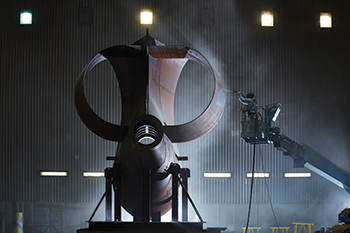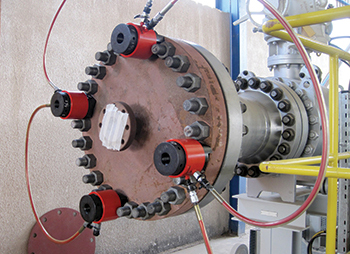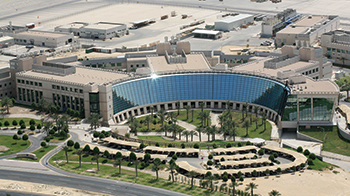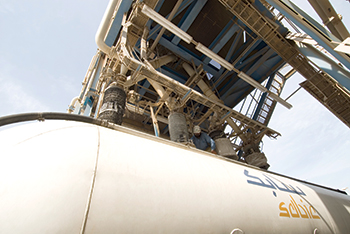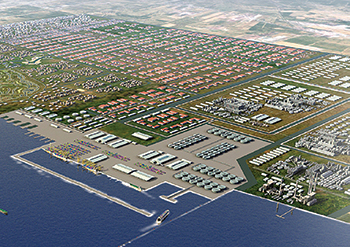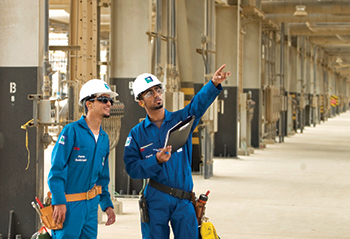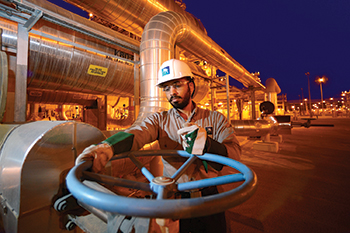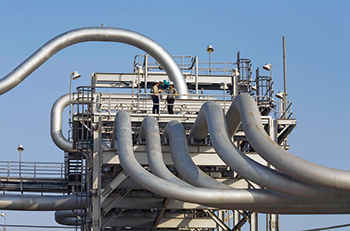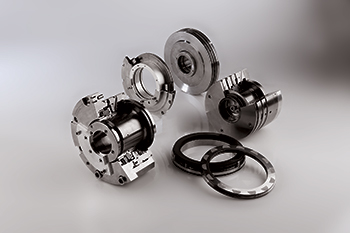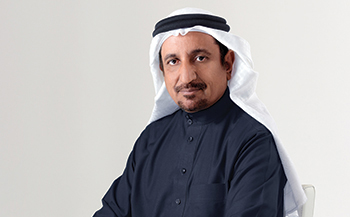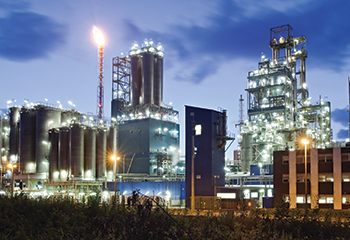.jpg)
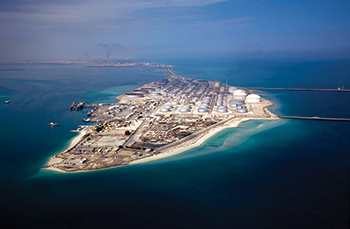 Ras Tanura refinery has undergone many upgrades
Ras Tanura refinery has undergone many upgrades
The Ras Tanura refinery is Aramco’s biggest, oldest and most complex refinery. Originally founded in 1945, it has undergone many upgrades and expansions
Saudi Aramco’s thrust in the refining sector is evident in the number of refineries it owns in the kingdom and the joint ventures it has in all over the world.
In the kingdom, the national oil company owns four refineries outright (Ras Tanura, Jeddah, Riyadh and Yanbu) and equity shares in a further three (Rabigh, Sasref and Samref). Two new joint venture (JV) refineries at Jubail (Satorp) and Yanbu came on stream in 2013 and 2014 respectively.
In addition, Aramco hopes to increase its own capacity through three additional refinery projects which are currently under way. Aramco has five foreign partners in JVs, three of which are in existing refineries.
The international oil company (IOC) with the greatest involvement in Saudi Arabian refining is ExxonMobil, which operates the 400,000 bpd Samref refinery in Yanbu through a 50:50 partnership with Aramco. Lubricating base oils are produced at the Lubref facilities in Jeddah and Yanbu, which is a 30:70 JV between ExxonMobil and Aramco.
Ras Tanura Refinery
The Ras Tanura refinery is Saudi Aramco’s biggest, oldest and most complex refinery. Originally founded in 1945, the refinery has undergone many upgrades and expansions. As well as a 550,000 bpd crude distillation unit, the refinery has a 305,000 bpd NGL processing unit and a 960,000 bpd crude stabilisation unit. The refinery is the only one in the kingdom to include a visbreaker. The refinery mainly supplies the domestic market through the Dhahran bulk plant, although some of the products are exported.
An $8 billion project to nearly double the capacity of the refinery to 950,000 bpd but by 2012 had been delayed, according to an Aramco statement in April 2009. The project had been expected to include the construction of a new crude distillation unit and vacuum distillation unit, as well as a diesel hydrotreater, a continuous catalyst regenerator and a sulphur unit. The expansion of the refinery was intended to supply feedstock to a petrochemical plant JV between Dow Chemical and Aramco.
In September 2013, Aramco extended the deadline for companies to bid for construction of a clean fuels and aromatics project at its largest Ras Tanura according to industry sources. The Ras Tanura clean fuels and aromatics project due on line by 2016 is part of Aramco’s second phase of its refineries upgrade. However based on delays at Ras Tanura and elsewhere, we have yet to pencil in any additional capacity for now pending greater clarity.
Samref Refinery
The Aramco-ExxonMobil Samref refinery JV is located in the port of Yanbu on the Red Sea Coast. With a capacity of 400,000 bpd, it is the second largest refinery in the kingdom and the largest single-train refinery in the world.
According to Aramco, around half of the refinery’s output is consumed domestically and it is the largest supplier of gasoline to the domestic market in the west of the country. The refinery’s slate is divided into gasoline (35 per cent), jet (15 per cent), diesel fuel and heating oil (30 per cent), fuel oil (15 per cent) and LPG (15 per cent). As well as the refinery’s 13 different processing units, the facility has an oil storage capacity of 13.2 million bbl. Aramco reported tat the facility was due to come online Q314 and produce around 3,000 bpd of benzene, 263,000 bpd of diesel, 90,000 bpd of gasoline and 6,200 tonnes per day of petroleum coke with another 1,200 tonnes per day of sulphur.
 |
Rabigh ... expanding capacity |
PetroRabigh Refinery
Japan’s Sumitomo Chemical owns 37.5 per cent of the Petro Rabigh JV, which owns a refinery at Rabigh that commenced operations on May 19 2009 and produces 400,000 bpd. The remaining 62.5 per cent of the company is owned by Saudi Aramco (37.5 per cent) and private shareholders (25 per cent).
Under a deal agreed in May 2004, Aramco agreed to supply the project with 400,000 bpd of crude, as well as ethane and butane, while Sumitomo provided petrochemical technology and its extensive marketing base.
The project is thought to have cost $10.1 billion, divided equally between the Japanese company and Aramco. In November 2009, the plant was officially inaugurated and it was announced that it would achieve 100 per cent of its production capacity during December 2009.
In April 2010, PetroRabigh issued solicitations of interest to contractors for the planned $6.67 billion second phase of the petrochemicals complex. An expansion of the facility’s ethane cracker is being considered to increase feedstock throughput by 850,000 cubic metres per day, as is the construction of a new aromatics complex with annual naphtha feedstock of 3 million tonnes per annum (tpa). Aramco is considering an expansion of the facility in line with its broader petrochemical plans.
 |
Sasref ... $267 million has been invested in modernising its refining unit |
Jubail Sasref Refinery
Shell’s assets in Saudi Arabia include the 305,000 bpd Saudi Aramco Shell Refinery (Sasref) in Jubail, a 50:50 JV between Shell and Aramco. May 2005 saw Sasref announce plans to invest over $267 million in modernising its refining unit. Sasref’s plans included building an LPG production unit at the site and installing technology to reduce the sulphur content of its diesel. Aramco and Shell inaugurated a new 100,000 bpd low-sulphur diesel unit at Sasref in March 2010.
 |
Satorp has raised $8.5 billion for the Jubail refinery |
Jubail Satorp Refinery
Satorp, which is jointly owned by Saudi Aramco and Total, has raised $8.5 billion for the Jubail refinery. The company secured $4.01 billion from the Public Investment Fund and Export Credit Agencies and the remaining $4.49 billion from commercial financial institutions. The 400,000 bpd full conversion refinery began operations in 2013.
The refinery will be able to produce 700,000tpa of paraxylene, 140,000 tpa of benzene and 200,000 tpa of polymer-grade propylene. Initially, the costs for the JV were estimated at $6 billion, but by November 2008 the projected cost had risen to around $10 billion. The Jubail refinery will process Arabian Heavy crude. Satorp has started testing at the $14 billion refinery in Jubail. The refinery is set to be fully online in 2014 and is expected to export large volumes of diesel and gasoline to Asia and Europe.
Jizan Refinery (Planned)
The decision to build a refinery in Jizan was announced in 2006 as part of the Jizan Industrial City project. Saudi Aramco’s Jazan Refinery will process 400,000 barrels per day (bpd) of Arabian Heavy and Arabian Medium crude oil to produce gasoline, ultra-low sulphur diesel, benzene and paraxylene. A marine terminal on the Red Sea coast will accommodate Very Large Crude Carriers (VLCCs) for the supply of crude oil to the new refinery.
The refinery project aims to industrialise the undeveloped Jizan province in south-western Saudi Arabia, close to the border with Yemen. The refinery project has been delayed many times, pushing the completion deadline from 2013 to 2016 and now 2017.
The tender for the project, which was offered in 2009, attracted only two bids, both from local companies, and former Aramco executive Sadad al-Husseini was quoted by Reuters as saying that neither of the two bidders was in a position to execute a project of the size of Jizan. After a new tender, a Feed deal was finally awarded in February 2011, with the contract awarded to KBR.
The Jizan and Yanbu refineries are linked to the Manifa oil field redevelopment programme. Both refineries are designed to process the sour heavy crude from the field into refined products for export. One of the reasons for delay in the construction of the refineries has been Aramco’s desire to drive down costs, which has fed back into the Manifa project’s timeframe.
Yasref (Under Construction)
In late-July 2010, Aramco awarded several contracts to international companies to build the new 400,000 bpd Yanbu refinery. Former JV partner US major ConocoPhillips pulled out of the project in April 2010 and was replaced in March 2011 by China’s Sinopec.
Announced in 2006, Yanbu is designed primarily as an export refinery focusing on the European market, which has historically needed to import gasoil because of a structural deficit of gasoil-producing capacity in its own plants. Located on the Red Sea, it is well placed to supply the Mediterranean Basin, the Arabian Gulf and even the Rotterdam hub, providing good opportunities for Sinopec’s new oil trading team in Europe, which was set up in December 2010. As the refinery will be fed from the redevelopment of the giant Manifa heavy sour crude project, it will also give Sinopec access to additional Saudi crude volumes as soon as they come on stream.
According to an Aramco press release, contracts for major processing units at the plant were awarded to seven companies. South Korea’s SK Engineering and Daelim won a $560 million crude unit and a $1.7 billion gasoline and hydrocracker package respectively, while Spain’s Tecnicas Reunidas won a $770 million coker package. Egypt’s ENPPI was awarded a $400 million contract to build a tank farm. Three Saudi Arabian firms, Saudi Services, Dayim Punj Lloyd and Rajeh H Al-Marri won the remaining three contracts, but did not disclose the value of their winning bids.
Yasref will produce refined products that meet demand from emerging markets of Asia, the Middle East and Africa, as well as markets in Europe and the United States. The construction is expected to be completed in June 2014, with start-up commencing in September 2014 and the first commercial shipment of refined products expected in the fourth quarter of 2014.
Oil Processing Facilities
Oil is processed at the Abqaiq crude stabilisation plant complex, also known as Buqayq, currently the largest in the world. The complex, which is the main location for the processing of Arabian Light and Arabian Extra Light crude, has a capacity of around 7 mbpd. The facility is divided into three general parts: an oil processing area that converts sour crude into sweet crude, an NGL area and a utilities area that provides power and support for the other two areas. Because of its important role in processing much of the country’s crude oil and NGL and its location at the hub of the country’s pipeline network, Abqaiq has been a target for terrorist attacks.
The failed attack on the facility in February 2006 highlighted the dangers posed by Islamic militants to Saudi energy infrastructure. Responsibility for the attacks on Abqaiq was claimed by a group calling itself ‘al-Qaeda in the Arabian Peninsula’.
Service Stations
With relaxed laws making the establishment of fuels retail stations extremely easy, Saudi Arabia has seen a boom in the number of service stations. In 2007 the number was estimated at 70,000, although it is estimated that at least a quarter of these were not built according to safety regulations. More recently, pressure seems to have increased to close the stations. A particular example has been the move to close any petrol station deemed too close to a pharmacy.
Oil Terminals/Ports
Saudi Aramco operates oil export terminals at Duba, Jeddah, Jizan, Jubail, Ju’aymah and Ras Tanura, while PetroRabigh operates a terminal at Rabigh. The most significant of these are the Ras Tanura facility on the Persian Gulf and the Yanbu facility on the Red Sea.
Ras Tanura: The Ras Tanura oil terminal complex is located in the east of the country close to major producing fields, and is linked by subsea pipeline to the Ju’aymah offshore oil terminal. The terminal comprises three separate sections, known as the North Pier, South Pier and the Sea Islands. According to the Energy Information Administration (EIA), the Sea Islands terminal has a capacity of around 6 mbpd, with an additional 2.5 mbpd of capacity available at the two port terminals. In 2008 the facility transported around 75 per cent of the country’s crude oil exports.
Yanbu: Saudi Arabia’s second major export route is located at the Red Sea port of Yanbu. According to the EIA, the terminal has a capacity of around 4.5 mbpd of oil and 2 mbpd of NGL and refined products, and accounts for around a quarter of Saudi Arabia’s oil exports. The terminal, which was completed in 1982, was designed to reduce the country’s strategic dependence on export routes that passed through the Straits of Hormuz. An additional attraction of the location was its relative proximity to European markets, allowing tankers to cut around 7,000 km off the journey distance to Europe compared with transporting oil from the Gulf.
The Yanbu terminal is linked to the East-West oil pipeline and its parallel NGL pipeline, both of which transport liquids from production centres further east.
Ras Al-Ju’aymah: The Ras al-Ju’aymah oil terminal is located 11km offshore, close to the Ras Tanura oil terminal, to which it is linked by subsea pipeline. According to the EIA, the facility has a capacity of up to 3.6 mbpd.
Rabigh: The Rabigh oil terminal is operated by the PetroRabigh refining company under a five-year deal with Saudi Aramco signed in March 2006. The facility, which according to Aramco has a maximum offloading hourly rate of 110,000 bbl, was historically used to source crude oil from Yanbu for the PetroRabigh refinery, although since 2005 the East-West pipeline spur to Rabigh has reduced pressure on the port.
Oil Pipelines
According to the EIA, Saudi Arabia has around 15,000 km of oil pipelines, operated by Saudi Aramco. Although the country has several oil export pipelines, none are currently operational, meaning that all oil exports are sent via tanker terminals. The domestic pipeline network does play a role in the country’s exports, however, by transporting oil to the country’s west coast to the export terminal at Yanbu.
East-West Oil Pipeline: The 1,202 km East-West pipeline, also known as the Petroline, transports crude oil from the Abqaiq processing plants in the east of the country to refineries and export terminals in the west. The pipeline, which has a capacity of 5 mbpd, is operated by Saudi Aramco and transports mainly Arabian Light crude. A 146 km spur from the pipeline to the refinery and oil terminal at Rabigh was completed in 2005, allowing 600,000 bpd to be transported and reducing the need to transport oil to the Rabigh refinery by sea. The pipeline runs alongside a 290,000 bpd NGL pipeline which provides feedstock for petrochemical plants in Yanbu.
Shaybah-Abqaiq Pipeline: The Shaybah-Abqaiq pipeline runs north from the Shaybah oil field at the edge of the Rub Al-Khali to Saudi Aramco’s major oil processing centre at Abqaiq. The 638 km pipeline has a capacity of 660,000 bpd.
Saudi Arabia-Bahrain Pipeline: Saudi Arabia exports about 230,000 bpd of crude oil from Abqaiq to Bahrain via the AB-1 pipeline. All the crude is refined at Bahrain’s Sitra refinery. To boost export capacity, Bahrain is planning to replace the ageing pipeline with a new one.
The new pipeline project was originally announced in January 2009. The design and route planning for the pipeline was expected by end-2010, although this did not prove to be the case. The larger pipeline would increase Bahrain’s oil import capacity, but actual flows are likely to vary in the coming years should domestic oil output increase.
Trans-Arabian Oil Pipeline (Closed): The Trans-Arabian oil pipeline, also known as the Tapline, was Saudi Arabia’s longest pipeline until its closure in 1990, with a total length of 1,214 km. The pipeline, which was completed in 1950, had a theoretical capacity of 500,000 bpd. It originally transported oil from Saudi Arabia’s east coast through Jordan and Syria to the Lebanese port of Sidon. Following the Six Day War in 1967 the pipeline only supplied Jordan. Although the pipeline is currently unusable, negotiations have been started several times over reopening it.
IPSA Pipeline (Closed): The 1.65 mbpd Iraq Petroleum Saudi Arabia (IPSA) pipeline, which transported oil from Iraq through Saudi Arabia for export, was mothballed in 1991 following the Gulf War. Although Iraq is looking at ways of increasing its crude oil export capacity, there are currently no plans to reopen the IPSA pipeline.
Gas Pipelines
Saudi Arabia currently has no gas export pipelines and a relatively limited domestic gas distribution network, known as the Master Gas System (MGS). Construction work started on the MGS in 1975 as a way of reducing flaring of associated gas and the bulk of the network was completed by the mid-1980. The pipeline network is fed by 64 gas separator plants and is linked to three gas processing plants at Shedgum, Uthmaniyah and Berri. NGLs from the MGS system are fed into the East-West NGL pipeline at Shedgum, from where they are transported to Yanbu on the Red Sea.










































































